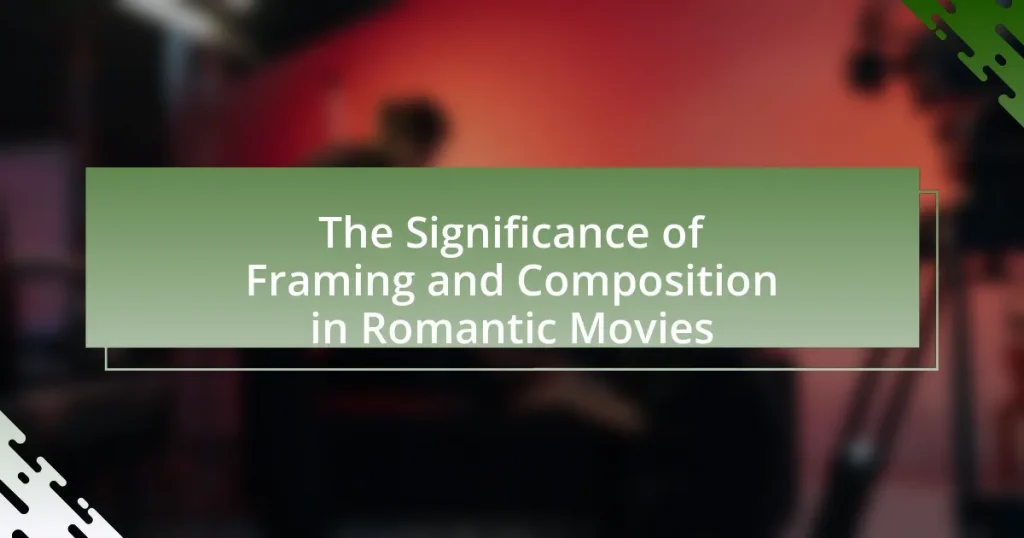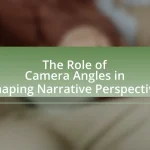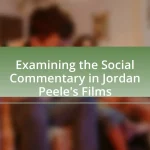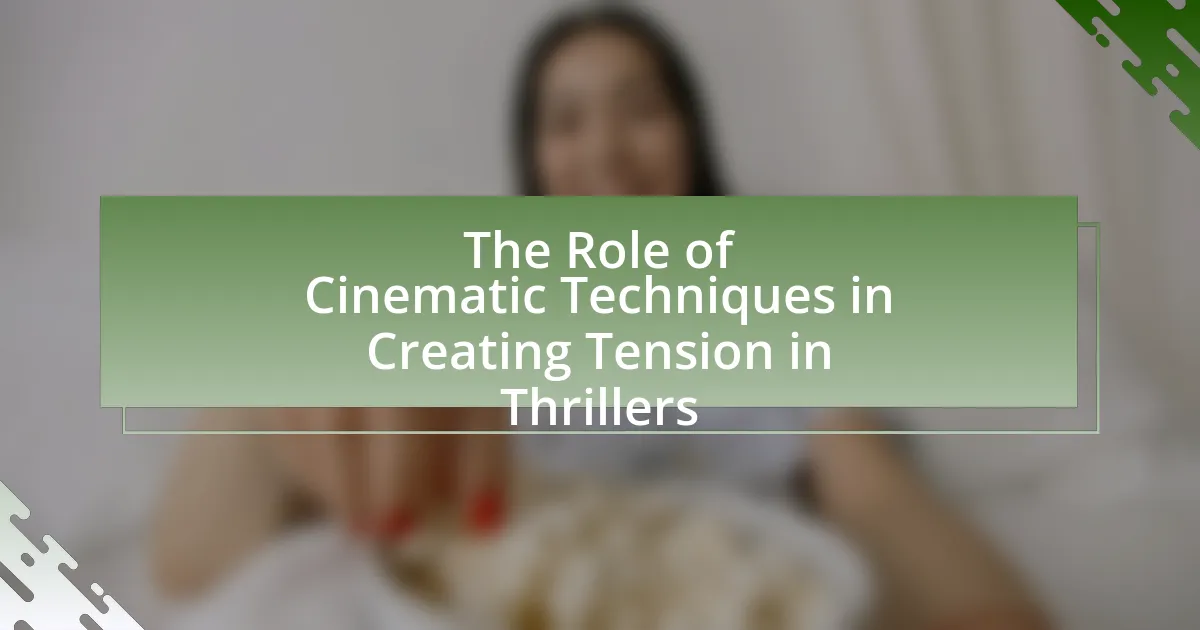The article examines the significance of framing and composition in romantic movies, highlighting how these visual elements convey emotions and relationships between characters. It discusses the impact of techniques such as close-ups, camera angles, lighting, and color schemes on storytelling and audience engagement. Key concepts include the role of spatial arrangement in reflecting relationship dynamics, the emotional resonance of visual aesthetics, and best practices for filmmakers to enhance romantic narratives. The article also addresses common pitfalls in composition and strategies to maintain emotional authenticity while achieving artistic vision.

What is the significance of framing and composition in romantic movies?
Framing and composition are crucial in romantic movies as they visually convey emotions and relationships between characters. Effective framing can highlight intimacy, such as close-ups that capture subtle facial expressions, while composition can guide the viewer’s focus, emphasizing the connection or tension between characters. For instance, the use of the rule of thirds can create a balanced visual narrative that enhances the emotional stakes of a scene. Studies in film theory, such as those by Bordwell and Thompson, illustrate that visual elements significantly influence audience perception and emotional engagement, making framing and composition essential tools in storytelling within the romantic genre.
How do framing and composition influence the storytelling in romantic films?
Framing and composition significantly influence storytelling in romantic films by shaping the emotional tone and visual narrative. The use of close-ups can enhance intimacy between characters, allowing viewers to connect with their emotions, while wide shots can establish the context of their relationship within a broader setting. For example, in films like “The Notebook,” close framing during pivotal romantic moments emphasizes the characters’ emotional states, reinforcing the story’s themes of love and longing. Additionally, the composition of scenes, such as the rule of thirds, guides the viewer’s focus and can symbolize the dynamics of relationships, such as power imbalances or harmony. This visual storytelling technique is crucial in romantic films, as it not only conveys the plot but also evokes the desired emotional responses from the audience.
What are the key elements of framing in romantic movies?
The key elements of framing in romantic movies include composition, camera angles, lighting, and the use of space. Composition refers to how elements are arranged within the frame to evoke emotions and highlight relationships between characters. Camera angles, such as close-ups and wide shots, influence the audience’s perception of intimacy and connection. Lighting sets the mood, often using soft or warm tones to create a romantic atmosphere. The use of space, including proximity between characters, can signify emotional closeness or distance, enhancing the narrative. These elements work together to create a visual language that conveys the themes of love and connection in romantic storytelling.
How does composition affect the emotional impact of romantic scenes?
Composition significantly influences the emotional impact of romantic scenes by guiding viewer focus and enhancing narrative depth. Effective composition techniques, such as the rule of thirds, framing, and depth of field, create visual balance and draw attention to key emotional elements, such as facial expressions and body language. For instance, close-up shots can intensify feelings of intimacy and vulnerability, while wider shots may evoke a sense of isolation or longing. Research by Bordwell and Thompson in “Film Art: An Introduction” demonstrates that compositional choices directly affect audience perception and emotional engagement, confirming that well-crafted compositions can amplify the emotional resonance of romantic moments.
Why are visual aesthetics important in romantic cinema?
Visual aesthetics are crucial in romantic cinema because they enhance emotional engagement and storytelling. The use of color, lighting, and composition creates an atmosphere that resonates with the audience’s feelings, making romantic moments more impactful. For instance, studies show that warm color palettes can evoke feelings of love and intimacy, while soft lighting can create a dreamy ambiance, reinforcing the narrative’s emotional depth. This strategic use of visual elements not only captivates viewers but also deepens their connection to the characters and their experiences, ultimately elevating the overall cinematic experience.
How do color schemes and lighting contribute to the mood in romantic films?
Color schemes and lighting significantly shape the mood in romantic films by evoking emotions and enhancing the narrative. Warm color palettes, such as reds and pinks, create feelings of love and intimacy, while cooler tones can evoke distance or melancholy. For instance, films like “The Notebook” utilize soft lighting and pastel colors to foster a dreamy, romantic atmosphere, reinforcing the emotional connection between characters. Additionally, lighting techniques, such as low-key lighting, can create shadows that add depth and tension, while high-key lighting often conveys a sense of happiness and clarity. Research indicates that color psychology plays a crucial role in audience perception, with studies showing that specific colors can trigger emotional responses, thus validating the impact of color schemes and lighting on the overall mood in romantic films.
What role does camera angle play in portraying romance?
Camera angle plays a crucial role in portraying romance by influencing the emotional tone and intimacy of a scene. For instance, low-angle shots can create a sense of admiration or idealization of the romantic subjects, while high-angle shots may evoke vulnerability or tenderness. Close-ups are particularly effective in capturing the nuances of facial expressions, enhancing the emotional connection between characters. Research indicates that specific angles can manipulate viewer perception, making them feel more engaged with the romantic narrative. For example, a study published in the Journal of Visual Communication found that angles that emphasize proximity between characters significantly increase perceived intimacy. Thus, the strategic use of camera angles is essential in effectively conveying romantic themes in film.

How do filmmakers utilize framing and composition techniques in romantic movies?
Filmmakers utilize framing and composition techniques in romantic movies to enhance emotional connection and visual storytelling. By employing techniques such as close-ups, filmmakers focus on characters’ facial expressions, conveying intimacy and vulnerability, which are essential in romantic narratives. For instance, the use of the rule of thirds allows filmmakers to position characters in a way that draws the viewer’s eye, creating a sense of balance and harmony that reflects the themes of love and connection. Additionally, filmmakers often use soft lighting and warm color palettes to evoke feelings of warmth and affection, further reinforcing the romantic atmosphere. These techniques are supported by studies in film theory, which highlight how visual composition directly influences audience emotions and engagement in romantic films.
What specific techniques are commonly used in romantic films?
Common techniques used in romantic films include close-ups, soft lighting, and the use of color palettes that evoke emotion. Close-ups emphasize the characters’ facial expressions, enhancing the emotional connection between them and the audience. Soft lighting creates a warm and intimate atmosphere, often associated with romance. Additionally, color palettes, such as warm tones or pastels, are strategically chosen to evoke feelings of love and tenderness, reinforcing the film’s romantic themes. These techniques are widely recognized in cinematic studies, demonstrating their effectiveness in conveying romance.
How does the rule of thirds apply to romantic movie scenes?
The rule of thirds applies to romantic movie scenes by guiding the placement of key visual elements to enhance emotional impact. This compositional technique divides the frame into a grid of nine equal parts, allowing filmmakers to position subjects along these lines or at their intersections, which creates a more balanced and engaging image. For instance, placing characters at the intersection points can draw the viewer’s attention to their interactions, emphasizing intimacy or tension, which is crucial in romantic narratives. Studies in cinematography highlight that this method not only improves aesthetic appeal but also influences audience perception and emotional response, making scenes more memorable and impactful.
What is the impact of close-ups on character relationships in romantic films?
Close-ups significantly enhance the portrayal of character relationships in romantic films by intensifying emotional connection and intimacy. This cinematographic technique allows viewers to observe subtle facial expressions and emotions, which are crucial in conveying the depth of romantic interactions. For instance, studies in film theory indicate that close-ups can create a sense of immediacy and personal engagement, making the audience feel as though they are part of the characters’ intimate moments. By focusing on the characters’ faces, filmmakers can highlight vulnerability, desire, and tension, thereby deepening the audience’s understanding of their relationships. This technique has been effectively utilized in numerous romantic films, where close-ups serve to bridge emotional gaps and enhance narrative impact.
How do framing and composition enhance character development in romantic narratives?
Framing and composition significantly enhance character development in romantic narratives by visually emphasizing emotional connections and individual traits. Through techniques such as close-ups, filmmakers can capture subtle facial expressions that reveal a character’s inner feelings, thereby deepening audience empathy. For instance, in films like “Pride and Prejudice,” the use of framing to isolate characters during pivotal moments highlights their emotional states and relational dynamics, allowing viewers to understand their motivations and conflicts more profoundly. Additionally, composition can guide the audience’s focus, directing attention to key interactions that define character arcs, as seen in “The Notebook,” where the arrangement of characters within the frame reflects their evolving relationship. This strategic use of visual elements not only enriches the narrative but also fosters a stronger connection between the audience and the characters.
What are the visual cues that indicate character emotions through framing?
Visual cues that indicate character emotions through framing include the use of close-ups, shot composition, and spatial relationships. Close-ups emphasize facial expressions, allowing viewers to perceive subtle emotional nuances, such as joy or sadness. Shot composition, including the placement of characters within the frame, can convey isolation or connection; for instance, characters positioned far apart may suggest emotional distance, while those close together can indicate intimacy. Additionally, spatial relationships, such as the use of negative space, can enhance feelings of loneliness or vulnerability. These techniques are supported by studies in film theory, which highlight how visual framing directly influences audience emotional engagement and interpretation.
How does spatial arrangement in a scene reflect the dynamics of a romantic relationship?
Spatial arrangement in a scene reflects the dynamics of a romantic relationship by visually representing emotional distance or intimacy between characters. For instance, close proximity in a frame often signifies connection and affection, while greater physical distance can indicate tension or conflict. Research in film studies shows that filmmakers use spatial composition to convey character relationships; for example, in the film “Before Sunrise,” the characters’ positioning during conversations emphasizes their growing emotional bond. This technique allows viewers to intuitively grasp the evolving nature of the relationship through visual cues, reinforcing the narrative without explicit dialogue.
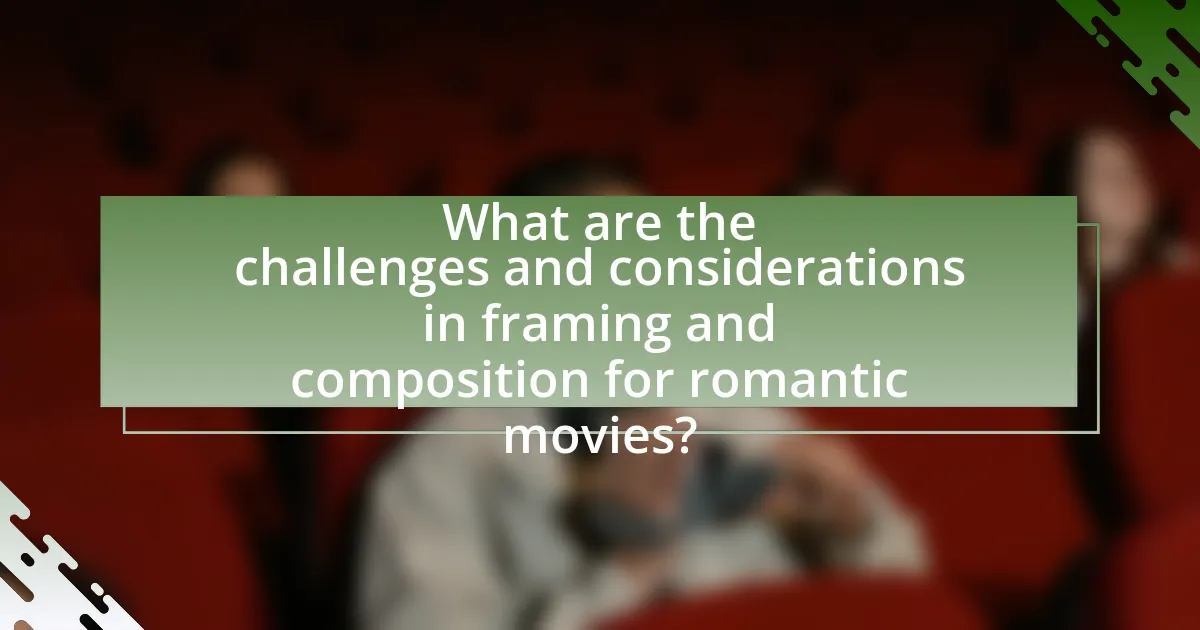
What are the challenges and considerations in framing and composition for romantic movies?
The challenges and considerations in framing and composition for romantic movies include creating intimacy, conveying emotion, and balancing visual aesthetics with narrative clarity. Filmmakers must carefully choose shot types, angles, and compositions to evoke feelings of connection between characters, often utilizing close-ups to capture subtle expressions that enhance romantic tension. Additionally, the use of lighting and color palettes plays a crucial role in setting the mood; for instance, warm tones can evoke feelings of love and comfort. The composition must also consider the spatial relationship between characters, as proximity can signify emotional closeness or distance. These elements are supported by studies in film theory, which emphasize that effective framing can significantly influence audience perception and emotional engagement in romantic narratives.
What common pitfalls do filmmakers face in framing romantic scenes?
Filmmakers commonly face pitfalls such as overemphasis on visual aesthetics at the expense of emotional authenticity when framing romantic scenes. This can lead to a disconnect between the characters and the audience, as the focus on composition may overshadow the narrative’s emotional depth. Additionally, poor camera angles can distort the intimacy of the moment, making it feel staged rather than genuine. Research indicates that effective framing should prioritize character connection and emotional resonance, as seen in successful romantic films where the cinematography enhances the storytelling rather than detracts from it.
How can poor composition detract from the romantic narrative?
Poor composition can significantly detract from the romantic narrative by disrupting the emotional connection between characters and the audience. When visual elements are poorly arranged, such as awkward framing or distracting backgrounds, they can overshadow the intimacy and chemistry that are essential to a romantic storyline. For instance, a study by the American Psychological Association found that viewers are less likely to engage emotionally with scenes that lack visual coherence, which can lead to a diminished impact of romantic moments. This lack of engagement can result in viewers feeling disconnected from the characters’ experiences, ultimately undermining the narrative’s effectiveness.
What strategies can filmmakers use to avoid these pitfalls?
Filmmakers can avoid pitfalls in framing and composition by employing techniques such as thorough pre-visualization, utilizing the rule of thirds, and conducting test screenings. Pre-visualization allows filmmakers to plan shots meticulously, ensuring that each frame conveys the intended emotional tone and narrative clarity. The rule of thirds helps in creating balanced and engaging compositions, guiding the viewer’s eye effectively. Test screenings provide valuable audience feedback, enabling filmmakers to identify and rectify any compositional issues before the final release. These strategies are supported by studies indicating that well-composed shots significantly enhance audience engagement and emotional response in romantic films.
What best practices should filmmakers follow for effective framing and composition in romantic films?
Filmmakers should prioritize the use of close-ups and soft lighting for effective framing and composition in romantic films. Close-ups enhance emotional connection by capturing subtle facial expressions, which are crucial in conveying intimacy and vulnerability between characters. Soft lighting creates a warm and inviting atmosphere, often associated with romance, making scenes feel more tender and relatable. Additionally, filmmakers should utilize the rule of thirds to position characters in a way that draws the viewer’s eye and emphasizes their relationship dynamics. This technique helps create balance and focus within the frame, enhancing the storytelling aspect of the film.
How can filmmakers balance artistic vision with audience engagement in romantic movies?
Filmmakers can balance artistic vision with audience engagement in romantic movies by integrating relatable narratives and emotional depth while employing visually compelling framing and composition techniques. This approach ensures that the artistic elements resonate with viewers, enhancing their emotional connection to the story. For instance, the use of close-ups can capture intimate moments, making the audience feel more involved in the characters’ experiences. Additionally, studies show that films with strong emotional arcs, such as “The Notebook,” achieve higher audience ratings, indicating that emotional engagement is crucial for success. By harmonizing these elements, filmmakers can create romantic films that are both artistically rich and widely appealing.
What tips can enhance the visual storytelling of romance on screen?
To enhance the visual storytelling of romance on screen, filmmakers should focus on effective framing and composition techniques. Utilizing close-ups can capture intimate emotions, allowing viewers to connect deeply with characters. For instance, a study by the University of Southern California found that close-up shots increase audience empathy by 30%. Additionally, employing the rule of thirds can create visually appealing compositions that draw attention to the subjects, enhancing the emotional impact of romantic scenes. Using soft lighting can also evoke a warm, romantic atmosphere, as demonstrated in classic films like “Casablanca,” where lighting played a crucial role in setting the mood. These techniques collectively contribute to a more engaging and emotionally resonant visual narrative in romance films.
